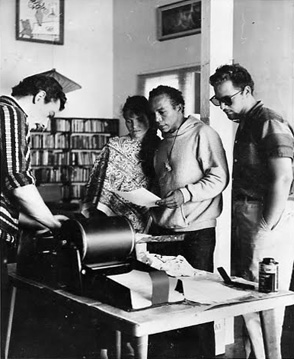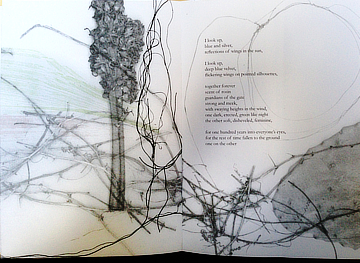Printing at Ciclostile Lab
At the Ciclostile Lab we print with an A3 Risograph and vintage Gestetner stencil duplicators.
The Lab is an independent publisher of artist publications, multiples, and other printed ephemera
based in the historic center of Florence, Italy.

Bill Margolis, Eileen Kaufman, Bob Kaufman,and unidentified man printing the first issue of Beatitude on stencil duplicating mimeograph machine.
Mimeograph Revolution
The mimeograph is a large, heavy, solid metal machine. Before a copy can be printed, a stencil needs to be made first. Most stencils were usually typewritten on, and then clipped onto the machine drum. A hand turned crank (later replaced by an electric motor) puts pressure between a sheet of paper and a cylinder as ink is forced through openings cut into the stencil.
The new poetry scenes of the late 50s and early 60s helped support various small presses and journals despite the odds of difficult distribution and financial instability. They would print on Gestetner mimeograph machines which allowed cheap and reasonably readable copies to be made and distributed quickly. Many of the beat writers produced works on mimeograph machines. Poet Allen Ginsberg self-produced first edition copies of Howl, his major work as a mimeograph. Presses associated with the Mimeo Revolution often published experimental and underground work, and were important venues for poets, writers and artists ignored by mainstream magazines. Their emphasis was often (but not always) on poetry, including work by the Black Mountain poets, the poets of the Beat Generation ,the New York School, and the San Francisco Renaissance, as well as such experimental genres as Concrete Poetry.
By the early 70s, the energy and mind-set of these networks were badly weakened and slowly dissipated. What these renegade poets, publishers and artists had in common, besides their independent nature, was the motivation and need to work within small groups and ensembles, to share their discoveries on small levels which might be considered insignificant by today's globally connected internet-generation.
Each of these small press mimeo-gangs participated in a small "collage" aesthetic. Working as tiny collectives they experimented patching new media together in unique designs and combinations. Presentation, delivery, politics and authorship were challenged. The mimeo revolution brought focus to these diverse trajectories. Ideas that were soon spilling over into the contemporary art scene battled there way awkwardly and beautifully through the pages of these small journals. Visually there is a conservative, reserved and serious look to the early mimeo sheets. Graphics were difficult if not almost impossible to portray, but often this obstruction would lead to some fascinating results. Binding was often the most utilitarian: staples. The limiting factor of graphic design, led to a strong emphasis on content.
By the time off-set and digital printing became standard and cheaply available, it coincided with a newer more visually centered psychedelic culture. Conceptual, psychedelic and distorted "mutant" forms of art were created across all mediums. Poetry, underground comix, posters, artist books, film and music were mixed and remixed. A new visual language grew out of the language obsessed mimeo-zines.
The mimeograph is now a forgotten medium, replaced by high speed copiers, computers and digital printers. There are no longer parts made for mimeograph machines and those that run are often restored from non-working machines . The art and knowledge of the stencil duplicating medium has been lost in time, only known only to those who were its early practitioners.
Excerpts from The Mimeograph Revolution by Cary Loren
Here at the Florence School of Fine Arts we have rediscovered the potential and creative possibilities of printing on Gestetner Duplicators. After finding several machines that were forgotten in time and stored away in garages, basements and storage units we began the task of restoring the machines back to working order. Currently we have six Gestetner machines, fully restored and operational that are used by students for printing. The Florence School is the only program in Italy offering courses and printing with Stencil Duplicating machines.

Detail of artist book “Adagio" by Melania Lanzini printed at Ciclostile Lab with Risograph Duplicatior
What is Risograph Printing
The Risograph, in a most basic sense, offers a return to tactility. The process is deliberate and inherently modest, and brings the production back into the artists’ studio and an intimate network of collaborators. The democratic possibility of-printing – in quantities that are responsive to the demand – as well as the close creative oversight afforded to artists at every step along the way embodies a set of new creative concerns important to contemporary image makers. The Risograph shares a legacy with Mimeograph printing, a hand ink-and-stencil printing method favored by artists.
The underlying technology of a risograph is very similar to screen printing or a mimeograph. It works by creating a master screen for each color of your artwork. This is then wrapped round a rotating drum. Ink is pushed through tiny holes in the screen and onto the paper, which is fed flat through the machine while the drum rotates at high speed to print each image on the paper.The process works by printing one color at a time. Multicolor images are created by switching the drum color and running the paper through the machine again creating layers in a process similar to screen printing.
The possibilities of riso-printing have been adopted by today’s artists and independent publishers who have given the machine a new purpose. Working with the strengths and limitations of the technology, they are creating artists’ books, posters, and zines that embrace a unique aesthetic and allow for endless experimentation with color, saturation and registration. Even the printing imperfections of the machine have a certain appeal, not unlike the aesthetic of old wood type.
VISIT US
Florence School of Fine Arts
Borgo Santa Croce 8
Florence, Italy 50122
CONTACT US
www.theflorenceschool.it
print@theflorenceschool.it
+39 331/102/0023